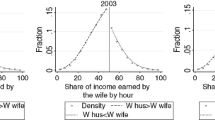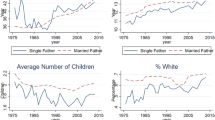Abstract.
This paper investigates the commonly asserted proposition that long term economic changes have put the family in a financial bind. Structural parameters of a family utility model are obtained by estimating simultaneous labor supply functions for a two-earner household. We find evidence indicating that the average 1990‘s two-earner family would prefer to receive the 1980‘s real wage package (were it available) instead of the real wage package it actually faces. The degree to which the 1990‘s family is worse off (in terms of the changes in the real wage package) is roughly equivalent to an hour of leisure per week.
Similar content being viewed by others
Author information
Authors and Affiliations
Additional information
Received September 25, 1995 / Accepted February 5, 1997
Rights and permissions
About this article
Cite this article
Hotchkiss, J., Kassis, M. & Moore, R. Running hard and falling behind: A welfare analysis of two-earner families. J Popul Econ 10, 237–250 (1997). https://doi.org/10.1007/s001480050041
Issue Date:
DOI: https://doi.org/10.1007/s001480050041




